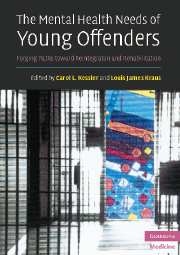Book contents
- Frontmatter
- Contents
- List of contributors
- Foreword
- Acknowledgments
- 1 An overview of child and adolescent mental health needs in the juvenile justice system
- 2 Psychiatric disorders of youth in detention
- 3 Disproportionate minority confinement
- 4 Police interrogation of youth
- 5 Assessing children's competence to stand trial and to waive Miranda rights: new directions for legal and medical decision-making in juvenile courts
- 6 The etiology of antisocial behavior: biopsychosocial risk factors across development
- 7 Substance abuse in youth offenders
- 8 Suicide and delinquent adolescents
- 9 Juvenile sex offenders
- 10 Educational needs of youth in the juvenile justice system
- 11 Science and the juvenile death penalty
- 12 Medical issues regarding incarcerated adolescents
- 13 Mental health screening and assessment in juvenile justice
- 14 Psychological testing in juvenile justice settings
- 15 Psychopharmacology and juvenile delinquency
- 16 Evidence-based treatment for justice-involved youth
- 17 Community alternatives to incarceration
- 18 Innovative problem-solving court models for justice-involved youth
- 19 Ethical issues of youthful offenders: confidentiality; right to receive and to refuse treatment; seclusion and restraint
- 20 Post-adjudicatory assessment of youth
- Index
- References
7 - Substance abuse in youth offenders
Published online by Cambridge University Press: 11 August 2009
- Frontmatter
- Contents
- List of contributors
- Foreword
- Acknowledgments
- 1 An overview of child and adolescent mental health needs in the juvenile justice system
- 2 Psychiatric disorders of youth in detention
- 3 Disproportionate minority confinement
- 4 Police interrogation of youth
- 5 Assessing children's competence to stand trial and to waive Miranda rights: new directions for legal and medical decision-making in juvenile courts
- 6 The etiology of antisocial behavior: biopsychosocial risk factors across development
- 7 Substance abuse in youth offenders
- 8 Suicide and delinquent adolescents
- 9 Juvenile sex offenders
- 10 Educational needs of youth in the juvenile justice system
- 11 Science and the juvenile death penalty
- 12 Medical issues regarding incarcerated adolescents
- 13 Mental health screening and assessment in juvenile justice
- 14 Psychological testing in juvenile justice settings
- 15 Psychopharmacology and juvenile delinquency
- 16 Evidence-based treatment for justice-involved youth
- 17 Community alternatives to incarceration
- 18 Innovative problem-solving court models for justice-involved youth
- 19 Ethical issues of youthful offenders: confidentiality; right to receive and to refuse treatment; seclusion and restraint
- 20 Post-adjudicatory assessment of youth
- Index
- References
Summary
Introduction
A Congressional study in 2004 found that two-thirds of juvenile detention facilities hold youth who are waiting for community based mental health care. Part of the lack of services can possibly be related to a shortage of both outpatient community based and inpatient beds. Overall, the number of inpatient psychiatric beds per capita for adults and children in the United States has dropped by 62 percent since 1970. Publicly run facilities (state and county) have had a more dramatic decline of 89 percent inpatient psychiatric beds per capita. Due to the lack of facilities, a 2003 study by the General Accounting Office found that 9000 families relinquished custody of their children to juvenile justice systems for the sole purpose of accessing mental health services they could not find or afford. However, in 2001, only 16 percent of crimes committed by juveniles were violent. So we have a history of decreased mental health services, increased numbers of youth who are housed in juvenile justice systems awaiting treatment, and insufficient resources either in the juvenile justice facilities or in the community to handle the needs of these youth (Koppelman, 2005).
Although adolescents in the juvenile justice system experience much higher rates of psychiatric disorders than adolescents in the general population (Shelton, 2001), what brings them to the attention of the juvenile justice system is an often co-occurring substance abuse disorder.
- Type
- Chapter
- Information
- The Mental Health Needs of Young OffendersForging Paths toward Reintegration and Rehabilitation, pp. 146 - 179Publisher: Cambridge University PressPrint publication year: 2007



